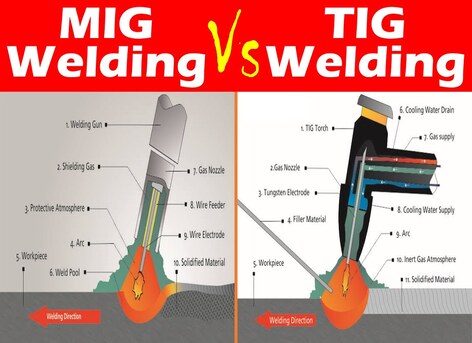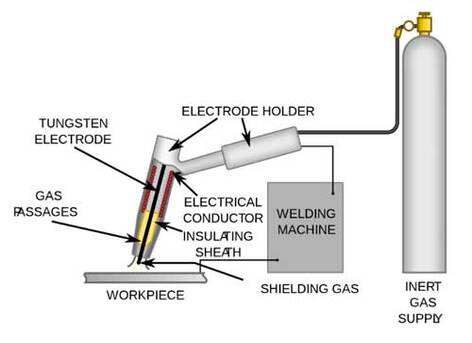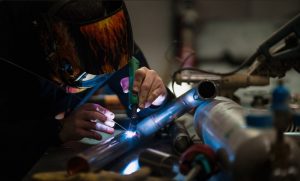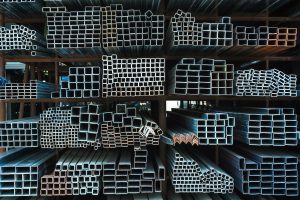TIG welding, or Tungsten Inert Gas welding, allows welders to create precise, clean welds using a filler rod and a gas shield, often argon. Welders can gain a lot of control over the heat, ensuring the quality of each weld. This technique requires skill, but once mastered, it becomes an invaluable tool.
Common Applications of TIG Welding
Professionals frequently use TIG welding for projects that require precision, such as automotive repairs, aerospace manufacturing, and electronics. Its ability to create clean, durable welds makes it ideal for components that endure high stress. Many artists also rely on TIG welding for decorative welds in sculptures and metal art, as the process demands careful control and attention to detail.
Industrial Uses of TIG Welding
Industries like construction and pipeline welding benefit from TIG welding’s ability to form strong, corrosion-resistant bonds. This technique works particularly well with materials such as stainless steel, titanium, and nickel alloys. Additionally, automotive body repairs often require TIG welding, as it ensures precise and durable welds that withstand daily wear and tear.
What Materials Can You Weld with TIG?
TIG welding is a highly versatile technique that works with a range of metals. Common materials welded with this process include:
- Stainless Steel
- Titanium
- Copper Alloys
- Brass
- Aluminum
This flexibility makes TIG welding a preferred method for various welding tasks.
What is better MIG or TIG welding?
Short answer: It depends on the application.
There are lots of misconceptions out there about TIG welding and MIG welding. People who have never done either think they are exactly the same, but they aren’t. They have different setups and uses, so it’s important to understand the difference so your work can be best done with the right tool for what you are doing.

MIG welding is suited for more general applications such as joining metal to metal or welding a variety of non-ferrous metals together. In such cases, the filler metal can be a gas or air-shielded alloy. These can be found in every welding supply store and all of them will have TIG welders too.
The advantages of MIG welding are that the heat applied is controlled by the welder, unlike TIG welding where you must provide it yourself with a blow torch or gas torch. MIG welding speeds up the process because there is no spatter when you burn off excess filler metal to improve your welds.
What material can be weld by TIG?
The variety of alloys that can be welded by TIG welding is limited only by the imagination of the welder. The most common filler materials in TIG welding are copper, brass, stainless steel and titanium.

Many hard materials are possible as well, but they do require different setups and a different kind of skill. This is why each weld station has its own crafter who knows how to use certain alloys effectively.
TIG welding is not a radio-controlled process that can be dialed in and controlled like a robot welding machine. It requires finesse, care and practice in order to achieve good results.
TIG welding is used for an extensive range of applications, from the repair of automotive body panels to the integration of a small statue into the architecture around it. The TIG welder, or “guru” as they are sometimes called, is an essential tool for anyone who wants to get good results with their work.
Most welders have a TIG welder and a MIG welder available for their use. Some companies will also be able to supply you with a TIG torch if you need one. For those who want to purchase their own, they can find it in the welding supply stores. If you are working on artistic projects or are doing steel repair or construction, this will be an essential tool for your kit.
It is important to learn how to use any welding technology well in order to achieve the best results. TIG welding is no exception. This process requires skill and patience, but once you develop the skillset to do it properly, you can look forward to many years of productive use.
What material use in TIG Welding?
TIG welding is a type of arc welding that uses filler materials to complete the welds. This means that any filler metal can be used in conjunction with this technique, but there are specialty alloys for the purpose as well.
This table provides a list of alloys that can be used with TIG welding. It is by no means exhaustive and many other unique alloys are available in the marketplace, but it contains the most common materials that you will find in a welding supply store:
Alloy Use Titanium Used to weld titanium. Stainless Steel Used to weld stainless steels up to 300 series austenitic stainless steel and nickel alloys Copper and Copper Alloys Used for welding copper or copper alloys.
What is TIG welding best used for?
The best use for TIG welding is in any situation where you require a high level of control of the arc, especially when you are welding thin materials.
TIG welders have a lot to do with the techniques and skill of the welder, not so much with the machine itself. If you are working on something small and precise, this is an excellent choice for that task. Also if you need to be able to manipulate the heat exactly, then TIG welding may be a good option.
What materials can be welded with a TIG Welding?
TIG welding can weld many different metals, but the most common types are stainless steel, titanium and copper. Copper, brass and zinc alloys are also commonly used. The ability to weld in extreme heat makes TIG welding a very versatile tool for repair work. It rarely fails for this kind of work.
It can be used to weld non-ferrous metals together as well as common ferrous metals such as stainless steel and copper. It may also be used for welding aluminium, brass or zinc. It should always be noted that aluminium is thinner than most metals and the process of welding it is much different than other ferrous materials.
What is the best TIG welding process?
The best TIG welding process depends on the material being welded. Welder skills can make all the difference when it comes to achieving consistent results with a specific project or repair.
In most cases, forge welding is the best process for repairing small pieces of metal art or for repairing a car body panel. It gives the welder more control over the heat and enables a smoother weld.
Hard surfacing is the best process to use when TIG welding steel or carbon steel. The welder can achieve a higher level of penetration with this technique and it results in a smooth finish on the outside of the weld as well as on the inside.
Final Words
Whether you’re repairing automobile parts, creating metal art, or working in industrial settings, TIG welding proves essential. It offers great precision and flexibility, making it a versatile tool for a range of applications. With practice, you can master TIG welding and use it to achieve top-notch results.
Note: ElectroWeld is reader-supported. If you click a link and buy something we may receive a small commission at no extra cost to you., learn more on disclaimer.

Walton M. Edwards was born in 1994 in a coal mining town, he has worked as a welder, a hardware salesman, and as a pipe fitter and has been employed as a laborer for about fifty years. Walton is a native of Wabash County in Indiana, but he now resides in Bloomington, Indiana.




